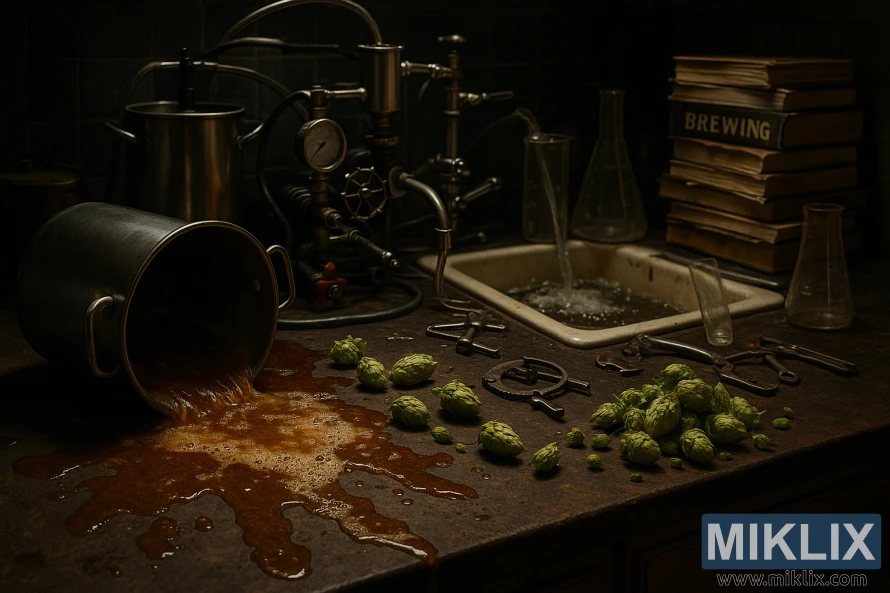Image: Brewing Mistakes with Melba Hops
Published: July 28, 2025 at 6:35:39 AM UTC
Last updated: September 27, 2025 at 11:59:17 AM UTC
A chaotic kitchen scene with spilled wort, scattered hops, and messy brewing gear under harsh light, reflecting mistakes in brewing with Melba hops.
The scene unfolds like a cautionary tale about the delicate balance between precision and chaos in the world of brewing. A single overhead light casts stark shadows across the cluttered countertop, illuminating the aftermath of what can only be described as a brewing disaster. In the foreground, a large steel pot lies tipped onto its side, its contents—amber-hued wort—spilled in a sticky cascade across the dark, weathered surface. The liquid pools and spreads in irregular patterns, catching the light in glistening streaks, as if mocking the brewer’s misstep. Just beside the spill, clusters of vibrant green Melba hop cones lie scattered, some still intact, others crushed or dampened by the errant wort. Their freshness and order stand in sharp contrast to the chaos surrounding them, silent reminders of the potential squandered by haste or inexperience.
The counter itself is littered with tools of the trade, though here they appear more like discarded relics than instruments of craftsmanship. Gears, clamps, and valves rest in disarray, as if hastily abandoned mid-task. Their iron surfaces reflect dull highlights, evoking an industrial harshness that only deepens the sense of disorder. Nearby, a stack of brewing manuals looms precariously, their spines cracked, pages dog-eared and stained, the word “Brewing” stamped boldly on the top volume. Yet their presence, once symbols of guidance and knowledge, now feels ironic—manuals unread or misunderstood, witnesses to mistakes born of neglect or overconfidence. Their looming shadow over the scene is almost judgmental, a silent indictment of theory ignored in practice.
Behind the counter, the sink overflows with sudsy water, an emblem of neglect and lack of control. Glassware—flasks, beakers, and measuring vessels—are strewn about, some tipped precariously against the sink’s edge, others clouded with residue. The water runs steadily from a spout, unchecked, echoing the broader theme of waste and mismanagement. The brew stand, half-assembled with pipes and valves askew, appears more like a jumble of unfulfilled potential than a functioning apparatus. It is as if the very heart of the brewing process has been abandoned mid-beat, leaving only confusion in its wake.
The lighting intensifies the mood, stark and dramatic, amplifying every spill, every imperfection, every detail of disarray. The shadows stretch long across the surface, giving the scene a theatrical tension, as though the viewer has stumbled into the middle act of a tragic play. The warmth of the light, which might otherwise have suggested coziness, instead sharpens the contrast between the beauty of the hops and the ugliness of the mistake. The effect is not unlike chiaroscuro painting, where the interplay of light and darkness lays bare the fragility of human endeavor.
Despite the overwhelming sense of failure, the image carries an undercurrent of possibility. The hops themselves, with their bright green vitality, suggest redemption—an ingredient that, when treated with respect, still holds the potential to transform wort into a beer of complexity and character. They embody a quiet resilience, standing out against the chaos as if to say that mistakes are not the end, but part of the learning process. The scene becomes less about catastrophe and more about humility, the recognition that brewing is as much about patience and attention as it is about creativity and experimentation.
Ultimately, the tableau is one of tension between aspiration and reality. The tools, manuals, and ingredients all hint at a brewer’s ambition, a vision of crafting something extraordinary with Melba hops and traditional methods. Yet the spill, the mess, and the neglected details remind us of the fragility of that vision when discipline falters. It is a portrait of the brewing journey not as a straight path to mastery but as a series of missteps, recoveries, and gradual refinement. The spilled wort may never become beer, but the lesson it leaves behind—the need for care, for respect of the process—will endure far longer.
The image is related to: Hops in Beer Brewing: Melba

